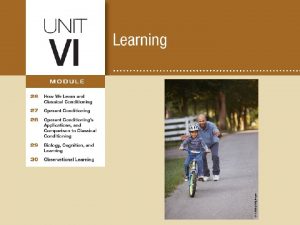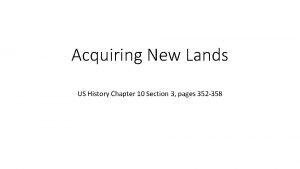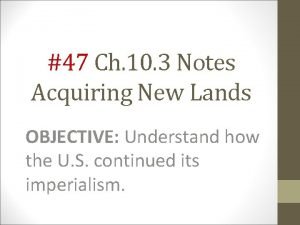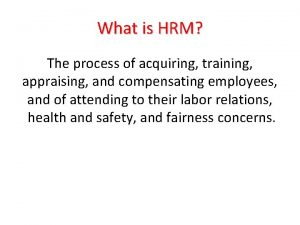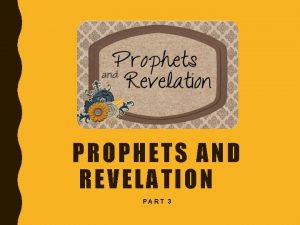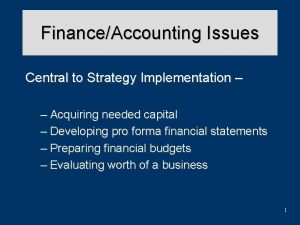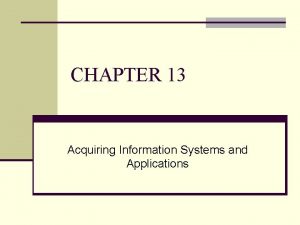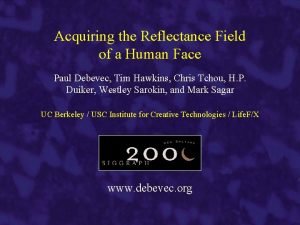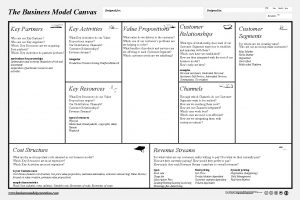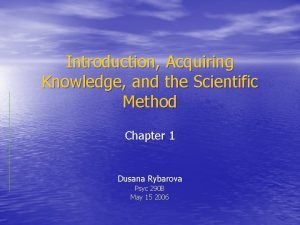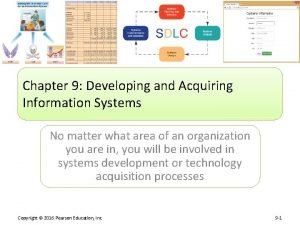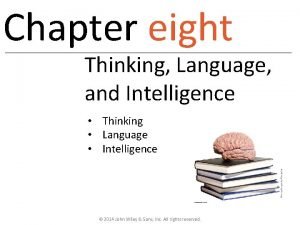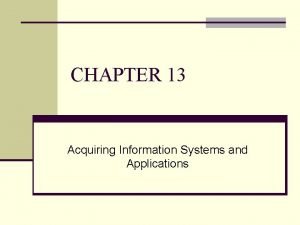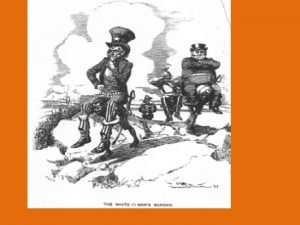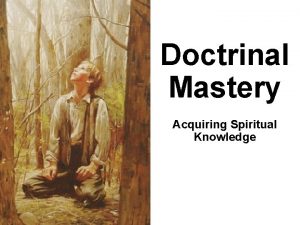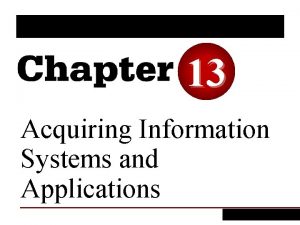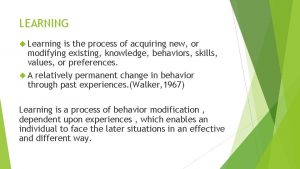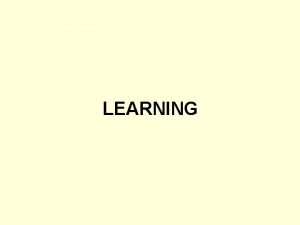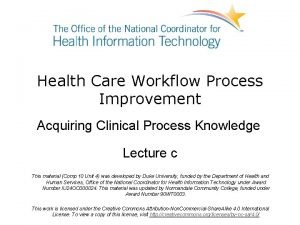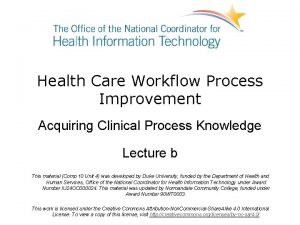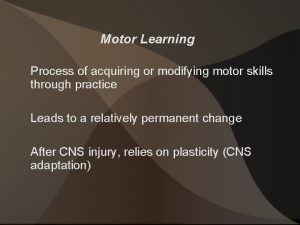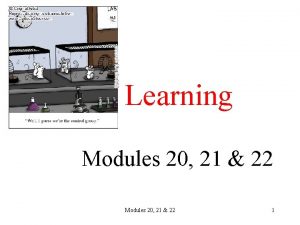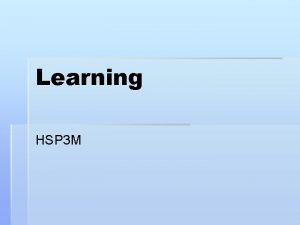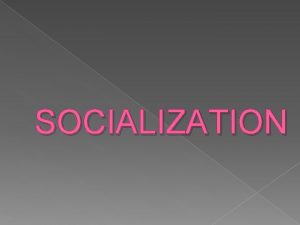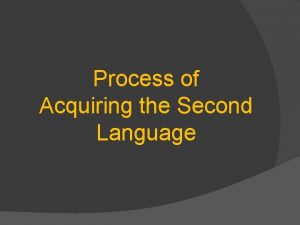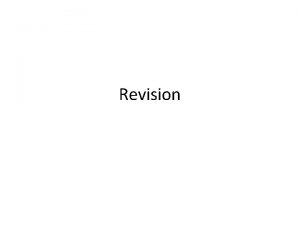LEARNING Learning is the process of acquiring new
















































- Slides: 48

LEARNING Learning is the process of acquiring new, or modifying existing, knowledge, behaviors, skills, values, or preferences. A relatively permanent change in behavior through past experiences. (Walker, 1967)

• Habituation Our response to unchanging stimuli decrease over time. This is aspect of adaption is a simple form of learning called Habituation. • Sensitization A simple form of learning, appears as an increase in responsiveness to a stimulus. Habitation and sensitization Provide organisms with useful way to adapt to their environment.

Learning theories • Associative learning theories are based on behaviorism where the stimulus-response relationship and the influence of environment are considered as the major sources of learning.

Learning theories • The cognitive learning theories involve thinking process and understandings. • cognitive learning theory is based on the cognitive model of human behavior, i. e. it emphasizes on the free will and positive aspects of human behavior. • Cognition refers to the individual’s thoughts, feelings, ideas, knowledge and understanding about himself and the environment. • Thus, an organism applies this cognition in learning which results in not merely the response to a stimulus, but the application of internal image of the external environment, so as to accomplish the goal.

BEHAVIOUR THEORIES • Classical Conditioning • Operant Conditioning ↓

Theory of Classical Conditioning • CONDITIONING: The modification of a natural response through artificial means is called conditioning • A learning process that occurs when two stimuli are repeatedly paired: a response which is at first elicited by the second stimulus is eventually elicited by the first stimulus alone.

BACKGROUND: • IVAN PAVLOV proposed theory of classical conditioning. • A Russian Physiologist • Studying the process of digestion in animals • Conducting experiments on dogs

EXPERIMENT: He fitted some pipes in the mouth of the dog to observe saliva secretion by seeing and smelling the food. he also arranged a bell. When the food was presented the bell also rang. he did this for many times i. e whenever He brought the food , before entering the room, he rang the bell. since here he changed the natural stimulus(food) with an artificial means(bell). he named this phenomenon as CONDITIONING


CONCLUSION OF HIS THEORY • THE theory of classical conditioning states that when a neutral stimulus is associated with a meaningful or natural stimulus, it produces a similar response as for the meaningful stimulus i. e UCS UCR After Many times repeated UCS + CS CR CS CR

Classical Conditioning Terminology • 1. ) Unconditioned Stimulus (US)- The stimulus that evokes a natural response. (food) • 2. ) Unconditioned Response (UR)- The natural reaction to the unconditioned stimulus. (salivation) • 3. ) Conditioned Stimulus (CS)- Previously neutral stimulus that, through conditioning, evokes conditioned response. (bell) • 4. ) Conditioned Response (CR)- Learned reaction to conditioned stimulus that occurs because of previous conditioning (salivation to bell)

Principles of classical conditioning Acquisition • This term refers to the learning of the conditioned response GENERALIZATION • A new stimulus similar to the learnt conditioned stimulus will also elicit the same conditioned response. • Eg, dog salivates on other bells DISCRIMINATION • The organism learns to respond towards particular stimulus and not towards all • Eg the dog learns the specific bell which follows food.

Principles of classical conditioning EXTINCTION • Extinction means the weakening of the conditioned response in the absence of the unconditioned stimulus. • Eg, dog stops salivation if the bell doesn’t follow the food. Spontaneous recovery • it means that he conditioned response appears again without further conditioning. • Extinction is not permanent. • Eg. the dog relearns the same response if presented the same stimulus in less time.

Theory of Operant Conditioning • The operant conditioning is also called instrumental conditioning. • Major contributors are B. F SKINNER and E. L THORNDIKE. • The OPERANT BEHAVIOR means the voluntary behavior with choices. • The OPERANT CONDITIONING is a form of learning where the consequences of a behavior produce changes in the probability of the behavior occurrence. • In classical conditioning , there is S-R bond whereas in operant stimulus is related to the response along with the end result. if result is good we will repeat the behavior if bad we will avoid it in both cases learning occurs.


Experiment • He put a rat in a closed box called skinner box. A hook in the box was fitted so that as soon as it was touched , a piece of food was dropped in the box. Skinner recorded the movements of the rate through mechanical means in order to have objective measurement. The experiment was too successful that at later stages he found the rat only touching the hook for getting food, without random movements. • These experiments support the law of effect by Thorndike.


Thorndike’s Law of effect • E, L Thorndike proposed his law of effect, according to which behaviors followed by positive outcomes are strengthened whereas the behaviors followed by negative outcomes are weakened.

Operant conditioning • Learning occurs as a result of consequences. • the component of learning expend to include a key characteristics: 1. Reinforcement 2. Punishment

Reinforcement • Reinforcement is a term refer to anything that increases the likelihood that a response will occur. • Reinforcement is defined by the effect that it has on behavior—it increases or strengthens the response.

Types of Reinforcement • In operant conditioning, there are two different types of reinforcement. Both of these forms of reinforcement influence behavior, but they do so in different ways. 1. Positive reinforcement involves adding something to increase a response, such as giving a bit of candy to a child after she cleans up her room. 2. Negative reinforcement involves removing something in order to increase a response, such as canceling a quiz if students turn in all of their homework for the week. By removing the aversive stimulus (the quiz), the teacher hopes to increase the desired behavior (completing all homework).



Schedule of Reinforcement • A schedule of reinforcement is a rule stating when and how often a behavior will be reinforced. • This is applicable when you are purposely trying to train and reinforce an action

Types of reinforcement schedules A). Continuous Reinforcement • the desired behavior is reinforced every single time it occurs. Generally, this schedule is best used during the initial stages of learning in order to create a strong association between the behavior and the response. B). Partial Reinforcement the response is reinforced only part of the time. • 1. Fixed-ratio schedules • 2. Variable- ratio schedules • 3. Fixed-interval schedules • 4. Variable-interval schedules

Schedules of partial reinforcement: • 1. Fixed-ratio schedules are those where a response is reinforced only after a specified number of responses. • 2. Variable- ratio schedules occur when a response is reinforced after an unpredictable number of responses. • 3. Fixed-interval schedules are those where the first response is rewarded only after a specified amount of time has elapsed. • 4. Variable-interval schedules occur when a response is rewarded after an unpredictable amount of time has passed

Punishment • Punishment is a kind of stimulus that aims to decrease the strength in behaviour due to its consequence. Punishment is the presentation of an adverse event or outcome that causes a decrease in the behavior it follows. There are two kinds of punishment: • Positive punishment, sometimes referred to as punishment by application, presents an unfavorable event or outcome in order to weaken the response it follows. Spanking for misbehavior is an example of punishment by application. • Negative punishment, also known as punishment by removal, occurs when a favorable event or outcome is removed after a behavior occurs. Taking away a child's video game following misbehavior is an example of negative punishment.

Negative punishment is more effective if: • It immediately follows a response. • It is applied consistently.


cognitive learning • The cognitive learning theories involve thinking process and understandings. • cognitive learning theory is based on the cognitive model of human behavior, i. e. it emphasizes on the free will and positive aspects of human behavior. • Cognition refers to the individual’s thoughts, feelings, ideas, knowledge and understanding about himself and the environment. • Thus, an organism applies this cognition in learning which results in not merely the response to a stimulus, but the application of internal image of the external environment, so as to accomplish the goal.

Cognitive Learning Theory • Edward Tolman has contributed significantly to the Cognitive Learning Theory. • According to him, individuals not only responds to stimuli but also act on beliefs, thoughts, attitudes, feelings and strive towards goals. • In other words, An individual creates a cognitive map in his mind, i. e. an image of the external environment, preserves and organizes information gathered, as a result of the consequences of events encountered during the learning process. Thus, the organism learns about the event and objects on the basis of a meaning assigned to stimuli.

• cognitive learning theory is based on the cognitive model of human behavior, i. e. it emphasizes on the free will and positive aspects of human behavior. • Cognition refers to the individual’s thoughts, feelings, ideas, knowledge and understanding about himself and the environment. Thus, an organism applies this cognition in learning which results in not merely the response to a stimulus, but the application of internal image of the external environment, so as to accomplish the goal.

• Tolman has conducted an experiment to elucidate the cognitive learning theory. He trained a rat to turn right in the ‘T’ maze in order to obtain food. One day, he started a rat from the opposite part of the maze, according to the operant conditioning theory, the rat should have turned right due to the past conditioning, but instead, it turned towards where the food was kept. • Thus, Tolman concluded that rat formed a cognitive map in its mind to figure out where the food has been placed, and reinforcement was not a precondition for learning to take place.

• Cognitive process in learning comes from research on learned helplessness, latent learning, cognitive maps, insight and observational learning.

Learned helplessness • Learned helplessness, a tendency to give up any effort to control the environment. • Learning that responses do not affect consequences, resulting in failure to try exert control over environment.

• Latent learning is a type of learning which is not apparent in the learner's behavior at the time of learning, but which manifests later when a suitable motivation and circumstances appear. While you might have learned how to cook a roast by watching your parents prepare dinner, this learning may not be apparent until you find yourself having to cook a meal on your own. But not all learning is immediately apparent. Sometimes learning only becomes evident when we need to utilize it.

Cognitive map A mental representation of the environment.



• Köhler placed a chimpanzee named Sultan inside a cage. Sultan grew hungry and a bunch of banana was placed just outside the cage. Sultan was provided with one long and another short bamboo stick. Neither of the sticks could reach the banana alone and the only possible way to reach the banana was to join the two sticks. • Initially, Sultan showed all customary reactions that a chimpanzee shows inside a cage, and gradually tried to draw the banana towards him with the sticks. After countless fruitless efforts, Sultan nearly gave up, but as he was playing with the sticks, he managed to touch the banana by pushing a stick with another stick. Sultan accidentally managed to join the two sticks and with its help, it pulled the banana inside the cage. Sultan immediately grabbed the banana when faced with the same problem next day.

characteristics of Insight Learning • Insight leads to change in perception. • Insight is sudden. • With insight, the organism tends to perceive a pattern or organization (that helps in learning). • Understanding plays important role n insight learning. • Insight is related with higher order animals and not with inferior animals. • Age influences insight learning. Adults are better learner than children. • Past experience and perceptual organization is important in perception.

Observational learning/ social learning • The process of learning by watching others is called observational learning or social learning. • Some observational learning occurs through vicarious experience, in which an individual is influenced by seeing or hearing about the consequences of others’ behaviour.

Albert Bandura - Bandura claimed that “in social situations, people often learn much more rapidly simply by observing the behaviors of others” - Bandura found that there are four components of observational learning: – – Attentional Processes Retention Processes Motor Reproduction Processes Reinforcement and Motivational Processes

Attentional Processes • One cannot imitate a model without paying attention to the model. • A model is often attractive because of the qualities he or she posses. These qualities such as prestige, power, and success gain the attention of the observer and begin the process of observational learning.

Retention Processes • Retention process is the way one remembers the model’s actions so he can imitate them. • Bandura explains, “In order to reproduce social behavior when the model is no longer present to serve as a guide, the response patterns must be represented in memory in symbolic form. • Example: mentally rehearsing the actions or practicing the actions will help one remember what he learned.

Motor Reproduction Processes • This is when a person uses the proper motor skills to accurately reproduce their model. • A five year old can observe his parent operate a car, but this does not mean he has the ability to correctly drive an automobile

Reinforcement and Motivational Processes • This process refers to the idea that a child will be more likely to imitate a behavior if he is likely to gain a reward • “When positive incentives are introduced, observational learning that previously remained unexpressed is likely to emerge in action. ”

Bobo Doll Experiment
 The process of acquiring through experience new
The process of acquiring through experience new Chapter 10 section 3 acquiring new lands
Chapter 10 section 3 acquiring new lands Acquiring new lands
Acquiring new lands Process of acquiring training appraising and compensating
Process of acquiring training appraising and compensating Learning means acquiring
Learning means acquiring Cost structure example business model canvas
Cost structure example business model canvas Acquiring spiritual knowledge part 1
Acquiring spiritual knowledge part 1 Acquiring capital to implement strategies
Acquiring capital to implement strategies Strategies for acquiring it applications
Strategies for acquiring it applications Acquiring the reflectance field of a human face
Acquiring the reflectance field of a human face Acquiring spiritual knowledge part 4
Acquiring spiritual knowledge part 4 Key partners example business model canvas
Key partners example business model canvas What are the different methods of acquiring knowledge
What are the different methods of acquiring knowledge Example of the acquiring information system novel plan is
Example of the acquiring information system novel plan is The mental activities involved in acquiring storing
The mental activities involved in acquiring storing Means acquiring goods and or services
Means acquiring goods and or services Acquiring information systems and applications
Acquiring information systems and applications Methods of acquiring information
Methods of acquiring information What factors did you consider in acquiring territories?
What factors did you consider in acquiring territories? Doctrinal mastery core document pdf
Doctrinal mastery core document pdf Acquiring information systems and applications
Acquiring information systems and applications Hát kết hợp bộ gõ cơ thể
Hát kết hợp bộ gõ cơ thể Lp html
Lp html Bổ thể
Bổ thể Tỉ lệ cơ thể trẻ em
Tỉ lệ cơ thể trẻ em Voi kéo gỗ như thế nào
Voi kéo gỗ như thế nào Tư thế worms-breton
Tư thế worms-breton Chúa yêu trần thế alleluia
Chúa yêu trần thế alleluia Môn thể thao bắt đầu bằng từ đua
Môn thể thao bắt đầu bằng từ đua Thế nào là hệ số cao nhất
Thế nào là hệ số cao nhất Các châu lục và đại dương trên thế giới
Các châu lục và đại dương trên thế giới Công của trọng lực
Công của trọng lực Trời xanh đây là của chúng ta thể thơ
Trời xanh đây là của chúng ta thể thơ Cách giải mật thư tọa độ
Cách giải mật thư tọa độ Làm thế nào để 102-1=99
Làm thế nào để 102-1=99 độ dài liên kết
độ dài liên kết Các châu lục và đại dương trên thế giới
Các châu lục và đại dương trên thế giới Thể thơ truyền thống
Thể thơ truyền thống Quá trình desamine hóa có thể tạo ra
Quá trình desamine hóa có thể tạo ra Một số thể thơ truyền thống
Một số thể thơ truyền thống Cái miệng bé xinh thế chỉ nói điều hay thôi
Cái miệng bé xinh thế chỉ nói điều hay thôi Vẽ hình chiếu vuông góc của vật thể sau
Vẽ hình chiếu vuông góc của vật thể sau Biện pháp chống mỏi cơ
Biện pháp chống mỏi cơ đặc điểm cơ thể của người tối cổ
đặc điểm cơ thể của người tối cổ V cc cc
V cc cc Vẽ hình chiếu đứng bằng cạnh của vật thể
Vẽ hình chiếu đứng bằng cạnh của vật thể Vẽ hình chiếu vuông góc của vật thể sau
Vẽ hình chiếu vuông góc của vật thể sau Thẻ vin
Thẻ vin đại từ thay thế
đại từ thay thế
